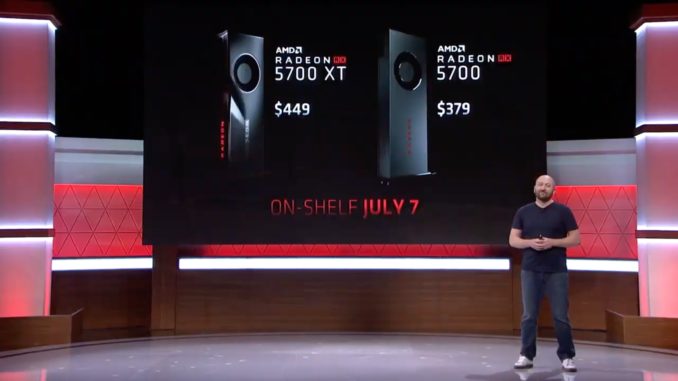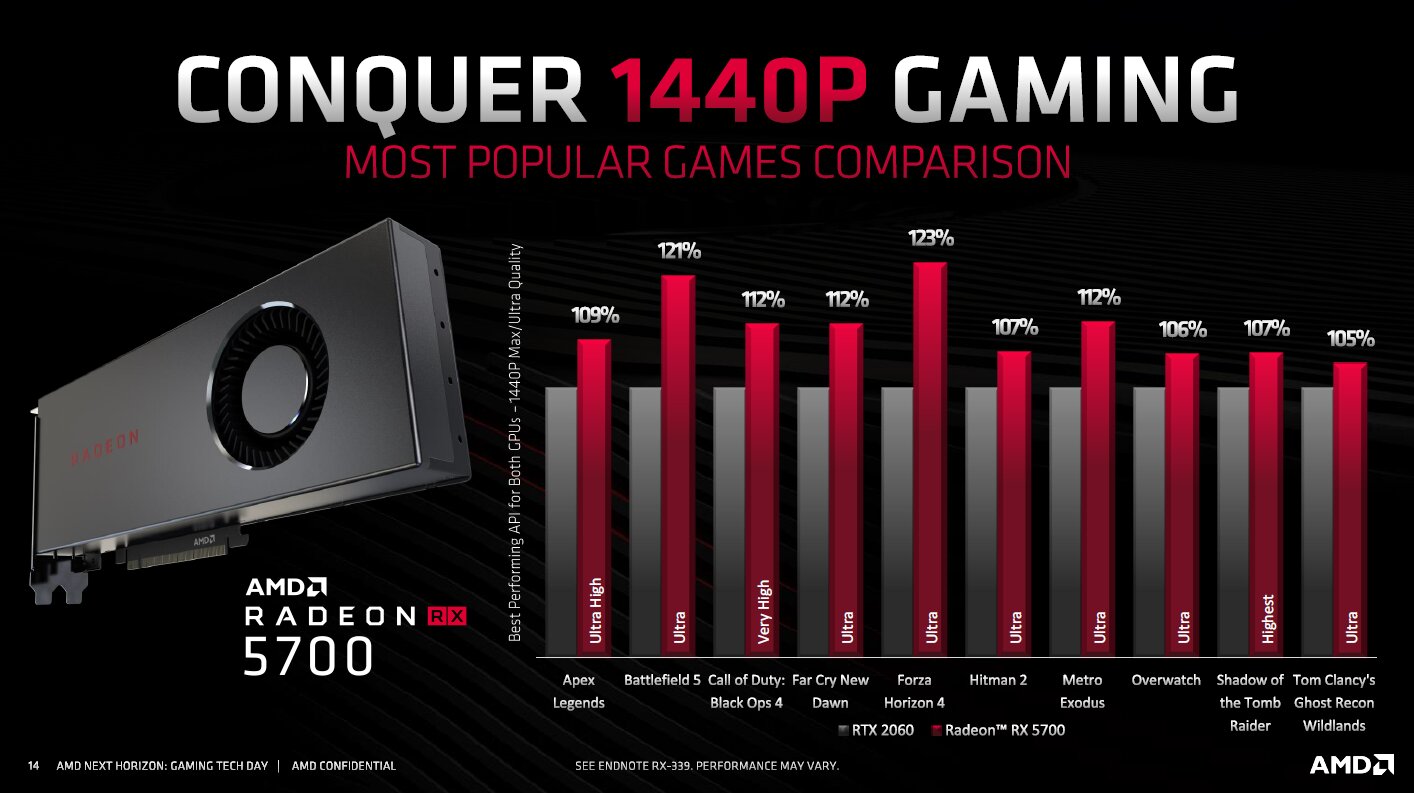
AMD introduced the new Radeon RX 5700 XT at the Next Horizon gaming event at E3 2019. It will compete for $449 against the RTX 2070.
AMD Navi: Radeon RX 5700 XT against the RTX 2070
At today’s Next Horizon Gaming event, AMD finally unveiled the new Radeon Navi graphics cards. The two graphics cards are named RX 5700 and RX 5700 XT. The RX 5700 XT is the top model and knows above all one opponent: the Nvidia GeForce RTX 2070.

The previously leaked technical data correspond one to one with the presented graphics cards. AMD packs 40 compute units into the RX 5700 XT, resulting in 2,560 shaders. There are 256 texture units and 64 raster operators. The GPU clocks at 1,905 MHz in boost mode and 1,605 MHz in standard mode. In addition there is a new specification from AMD, which is called Game Clock and is at 1,755 MHz. This is supposed to be the actual clock when gaming. The memory used is 8 gigabytes of GDDR6 connected to a 256 bit interface and clocked at 14 Gbps, resulting in 448 GB/s of bandwidth. The board power is 225 watts, AMD uses a 6-pin and an 8-pin connector on the RX 5700 XT. All this leads to an FP32 performance of 9.75 TFLOPs.
The leaked data on gaming performance is also correct. Accordingly, the RX 5700 XT achieves a better result than the RTX 2070 in eight out of ten games tested. Battlefield 5 and Metro Exodus stand out clearly with 22 and 15 percent higher performance, respectively.

Radeon RX 5700 is the RTX 2060 opponent
The Radeon RX 5700 is the only other Radeon Navi graphics card for the time being. It is a variant of the Navi 10 GPU that comes with 36 instead of 40 compute units. Therefore only 2,304 shaders, but still 256 texture units and 64 raster operators are used. However, the GPU also clocks much slower. The boost clock is 1,725 MHz, the base clock 1,465 MHz. The game clock is specified by AMD at 1,625 MHz. At least the memory was taken over from the big brother. The RX 5700 also has 8 gigabytes of GDDR6 with 14 Gbps speed installed. However, the current consumption is significantly lower. The board power of the RX 5700 is 180 watts. Nevertheless, a 6-pin and an 8-pin connector are installed. The FP32 power is 7.95 TFLOPs.
There is also a gaming benchmark course for the RX 5700, this time against the Nvidia GeForce RTX 2060, the declared opponent of the RX 5700. In the same benchmarks at WQHD resolution as with the RX 5700 XT, the RX 5700 outperforms the RTX 2060 in every benchmark. The performance increase varies from two percent at Assassin’s Creed Odyssey to 21 percent at Battlefield 5. 16 percent more power is available at Metro Exodus, 12 percent each at Call of Duty: Black Ops 4 and Far Cry: New Dawn.

Blower design with a concept
When designing the reference versions, AMD once again relied on a blower design. After the design with radial fan was already declared dead after the release of the Radeon VII, the Navi graphics cards again come with the air shovel. The two coolers are almost identical. The fan cools a vapor chamber, which is responsible for cooling the GPU. Both elements are connected with a graphite pad. Everything is encased in an aluminium case. Both the RX 5700 XT and the RX 5700 come with a backplate.

More details with FidelityFX, more power with Radeon Image Sharpening, Radeon Anti-Lag against input lag
With the Navi architecture, AMD has introduced new software features in addition to the new graphics cards. First of all: Raytracing is not yet a topic with Navi. There are neither own hardware units, nor are the shaders designed for raytracing. This will only become an area of interest with RDNA Next Gen, probably the second generation of Navi. The presented features therefore have different names. The first feature is FidelityFX, which is supposed to bring more details into games. Radeon Image Sharpening is an anti-aliasing method, but it’s not supposed to eat so much power. In the benchmarks presented by AMD, the loss is minimal. AMD also has another technology in its luggage. With Radeon Anti-Lag the input lag in games should decrease significantly.
$379 and $449, Special Edition for $499, launching on July 7
One of the most important points of the new Navi graphics cards is probably the price. During the presentation, AMD strongly emphasizes which opponents the two graphics cards have. So the RX 5700 XT beats the RTX 2070, and at a lower price. Unfortunately, AMD also orients itself towards its competitors. While the RTX 2070 started for $499, the RX 5700 XT costs a little less with $449. The RX 5700 as opponent of the RTX 2060 comes with a price tag of $379 on the market. As has already been reported for some time, the Radeon Navi graphics cards will actually be launched together with Ryzen 3000 on 7 July.
At the end of the presentation Lisa Su had a surprise at hand. She introduced the Radeon RX 5700 XT 50th Anniversary Edition, an even faster graphics card from the Navi series. This is an even higher clocked RX 5700 XT. It comes on 1,680 MHz base clock, 1,830 game clock and 1,980 boost clock and thus reaches 10.14 TFLOPs in performance. Instead of the red and silver design, the RX 5700 XT 50th Anniversary Edition is in gold and black. The graphics card will also be available for $499 exclusively through the AMD website from July 7 on.



Be the first to comment